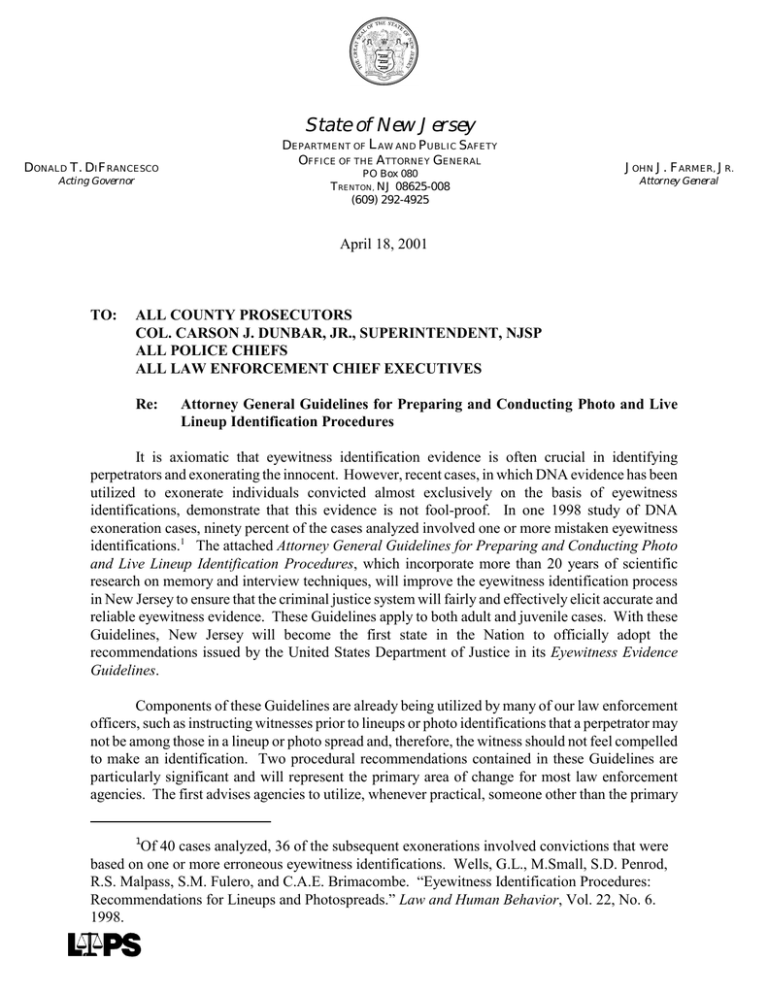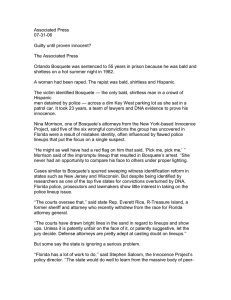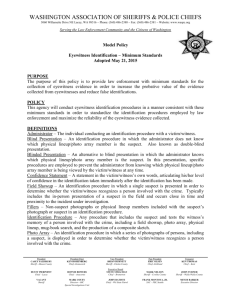State of New Jersey
advertisement

State of New Jersey DONALD T. DIFRANCESCO Acting Governor DEPARTMENT OF LAW AND PUBLIC SAFETY OFFICE OF THE ATTORNEY GENERAL PO Box 080 TRENTON, NJ 08625-008 (609) 292-4925 JOHN J. FARMER, JR. Attorney General April 18, 2001 TO: ALL COUNTY PROSECUTORS COL. CARSON J. DUNBAR, JR., SUPERINTENDENT, NJSP ALL POLICE CHIEFS ALL LAW ENFORCEMENT CHIEF EXECUTIVES Re: Attorney General Guidelines for Preparing and Conducting Photo and Live Lineup Identification Procedures It is axiomatic that eyewitness identification evidence is often crucial in identifying perpetrators and exonerating the innocent. However, recent cases, in which DNA evidence has been utilized to exonerate individuals convicted almost exclusively on the basis of eyewitness identifications, demonstrate that this evidence is not fool-proof. In one 1998 study of DNA exoneration cases, ninety percent of the cases analyzed involved one or more mistaken eyewitness identifications.1 The attached Attorney General Guidelines for Preparing and Conducting Photo and Live Lineup Identification Procedures, which incorporate more than 20 years of scientific research on memory and interview techniques, will improve the eyewitness identification process in New Jersey to ensure that the criminal justice system will fairly and effectively elicit accurate and reliable eyewitness evidence. These Guidelines apply to both adult and juvenile cases. With these Guidelines, New Jersey will become the first state in the Nation to officially adopt the recommendations issued by the United States Department of Justice in its Eyewitness Evidence Guidelines. Components of these Guidelines are already being utilized by many of our law enforcement officers, such as instructing witnesses prior to lineups or photo identifications that a perpetrator may not be among those in a lineup or photo spread and, therefore, the witness should not feel compelled to make an identification. Two procedural recommendations contained in these Guidelines are particularly significant and will represent the primary area of change for most law enforcement agencies. The first advises agencies to utilize, whenever practical, someone other than the primary 1 Of 40 cases analyzed, 36 of the subsequent exonerations involved convictions that were based on one or more erroneous eyewitness identifications. Wells, G.L., M.Small, S.D. Penrod, R.S. Malpass, S.M. Fulero, and C.A.E. Brimacombe. “Eyewitness Identification Procedures: Recommendations for Lineups and Photospreads.” Law and Human Behavior, Vol. 22, No. 6. 1998. Page 2 investigator assigned to a case to conduct both photo and live lineup identifications. The individual conducting the photo or live lineup identification should not know the identity of the actual suspect. This provision of the Guidelines is not intended to question the expertise, integrity or dedication of primary investigators working their cases. Rather, it acknowledges years of research which concludes that even when utilizing precautions to avoid any inadvertent body signals or cues to witnesses, these gestures do occur when the identity of the actual suspect is known to the individual conducting the identification procedure. This provision of the Guidelines eliminates unintentional verbal and body cues which may adversely impact a witness’ ability to make a reliable identification. I recognize that this is a significant change from current practice that will not be possible or practical in every case. When it is not possible in a given case to conduct a lineup or photo array with an independent investigator, the primary investigator must exercise extreme caution to avoid any inadvertent signaling to a witness of a “correct” response which may provide a witness with a false sense of confidence if they have made an erroneous identification. Studies have established that the confidence level that witnesses demonstrate regarding their identifications is the primary determinant of whether jurors accept identifications as accurate and reliable.2 Technological tools, such as computer programs that can run photo lineups and record witness identifications independent of the presence of an investigator, as well as departmental training of a broader range of agency personnel to conduct lineups and photo identifications may also assist agencies and departments with staff and budget constraints in implementing this recommendation. The Guidelines also recommend that, when possible, “sequential lineups” should be utilized for both photo and live lineup identifications. “Sequential lineups” are conducted by displaying one photo or one person at a time to the witness. Scientific studies have also proven that witnesses have a tendency to compare one member of a lineup to another, making relative judgements about which individual looks most like the perpetrator. This relative judgement process explains why witnesses sometimes mistakenly pick someone out of a lineup when the actual perpetrator is not even present. Showing a witness one photo or one person at a time, rather than simultaneously, permits the witness to make an identification based on each person’s appearance before viewing another photo or lineup member. Scientific data has illustrated that this method produces a lower rate of mistaken identifications.3 If use of this method is not possible in a given case or department, the Guidelines also provide recommendations for conducting simultaneous photo and live lineup identifications. 2 Cutler, B.L., and S.D. Penrod. “Mistaken Identification: The Eyewitness, Psychology, and the Law,” New York: Cambridge University Press, 1995; Wells, G.L. and Bradfield, A.L., “Distortions in Eyewitness Recollections: Can the Post-identification Feedback Effect be Moderated?”, Pyschological Science, 1999. 3 Wells, G.L., M.Small, S.D. Penrod, R.S. Malpass, S.M. Fulero, and C.A.E. Brimacombe. “Eyewitness Identification Procedures: Recommendations for Lineups and Photospreads.” Law and Human Behavior, Vol. 22, No. 6. 1998. Page 3 Although the Guidelines are fairly self-explanatory, their implementation will require a steep learning curve. To that end, training will be conducted. To accommodate appropriate training, the Guidelines will become effective within 180 days of the date of this letter. However, I would encourage you to implement the Guidelines sooner, if possible. I am requesting that each County Prosecutor designate key law enforcement personnel and police training coordinators to work with the Division of Criminal Justice to train your staff as well as the local law enforcement agencies within your jurisdiction. While it is clear that current eyewitness identification procedures fully comport with federal and state constitutional requirements, the adoption of these Guidelines will enhance the accuracy and reliability of eyewitness identifications and will strengthen prosecutions in cases that rely heavily, or solely, on eyewitness evidence. The issuance of these Guidelines should in no way be used to imply that identifications made without these procedures are inadmissible or otherwise in error. Your cooperation is appreciated as all members of our law enforcement community strive to implement these procedures. Should you have any questions regarding the implementation of these Guidelines, please contact the Division of Criminal Justice, Prosecutors & Police Bureau, at 609984-2814. Very truly yours, John J. Farmer, Jr. Attorney General Attachment cc: Director Kathryn Flicker Chief of Staff Debra L. Stone Deputy Director Wayne S. Fisher, Ph.D. Deputy Director Anthony J. Zarrillo, Jr. Chief State Investigator John A. Cocklin SDAG Charles M. Grinnell, Acting Chief, Prosecutors & Police Bureau ATTORNEY GENERAL GUIDELINES FOR PREPARING AND CONDUCTING PHOTO AND LIVE LINEUP IDENTIFICATION PROCEDURES PREAMBLE While it is clear that current eyewitness identification procedures fully comport with federal and state constitutional requirements, that does not mean that these procedures cannot be improved upon. Both case law and recent studies have called into question the accuracy of some eyewitness identifications. The Attorney General, recognizing that his primary duty is to ensure that justice is done and the criminal justice system is fairly administered, is therefore promulgating these guidelines as “best practices” to ensure that identification procedures in this state minimize the chance of misidentification of a suspect. I. COMPOSING THE PHOTO OR LIVE LINEUP The following procedures will result in the composition of a photo or live lineup in which a suspect does not unduly stand out. An identification obtained through a lineup composed in this manner should minimize any risk of misidentification and have stronger evidentiary value than one obtained without these procedures. A. In order to ensure that inadvertent verbal cues or body language do not impact on a witness, whenever practical, considering the time of day, day of the week, and other personnel conditions within the agency or department, the person conducting the photo or live lineup identification procedure should be someone other than the primary investigator assigned to the case. The Attorney General recognizes that in many departments, depending upon the size and other assignments of personnel, this may be impossible in a given case. In those cases where the primary investigating officer conducts the photo or live lineup identification procedure, he or she should be careful to avoid inadvertent signaling to the witness of the “correct” response. B. The witness should be instructed prior to the photo or live lineup identification procedure that the perpetrator may not be among those in the photo array or live lineup and, therefore, they should not feel compelled to make an identification. C. When possible, photo or live lineup identification procedures should be conducted sequentially, i.e., showing one photo or one person at a time to the witness, rather than simultaneously. D. In composing a photo or live lineup, the person administering the identification procedure should ensure that the lineup is comprised in such a manner that the suspect does not unduly stand out. However, complete uniformity of features is not required. E. Photo Lineup. In composing a photo lineup, the lineup administrator or investigator should: F. 1. Include only one suspect in each identification procedure. 2. Select fillers (nonsuspects) who generally fit the witness’ description of the perpetrator. When there is a limited or inadequate description of the perpetrator provided by the witness, or when the description of the perpetrator differs significantly from the appearance of the suspect, fillers should resemble the suspect in significant features. 3. Select a photo that resembles the suspect’s description or appearance at the time of the incident if multiple photos of the suspect are reasonably available to the investigator. 4. Include a minimum of five fillers (nonsuspects) per identification procedure. 5. Consider placing the suspect in different positions in each lineup when conducting more than one lineup for a case due to multiple witnesses. 6. Avoid reusing fillers in lineups shown to the same witness when showing a new suspect. 7. Ensure that no writings or information concerning previous arrest(s) will be visible to the witness. 8. View the array, once completed, to ensure that the suspect does not unduly stand out. 9. Preserve the presentation order of the photo lineup. In addition, the photos themselves should be preserved in their original condition. Live Lineups. In composing a live lineup, the lineup administrator or investigator should: 1. Include only one suspect in each identification procedure. 2. Select fillers (nonsuspects) who generally fit the witness’ description -2- of the perpetrator. When there is a limited or inadequate description of the perpetrator provided by the witness, or when the description of the perpetrator differs significantly from the appearance of the suspect, fillers should resemble the suspect in significant features. II 3. Consider placing the suspect in different positions in each lineup when conducting more than one lineup for a case due to multiple witnesses. 4. Include a minimum of four fillers (nonsuspects) per identification procedure. 5. Avoid reusing fillers in lineups shown to the same witness when showing a new suspect. CONDUCTING THE IDENTIFICATION PROCEDURE The identification procedure should be conducted in a manner that promotes the accuracy, reliability, fairness and objectivity of the witness’ identification. These steps are designed to ensure the accuracy of identification or nonidentification decisions. A. Simultaneous Photo Lineup: When presenting a simultaneous photo lineup, the lineup administrator or investigator should: 1. Provide viewing instructions to the witness as outlined in subsection I B, above. 2. Confirm that the witness understands the nature of the lineup procedure. 3. Avoid saying anything to the witness that may influence the witness’ selection. 4. If an identification is made, avoid reporting to the witness any information regarding the individual he or she has selected prior to obtaining the witness’ statement of certainty. 5. Record any identification results and witness’ statement of certainty as outlined in subsection II E, “Recording Identification Results.” -3- 6. Document in writing the lineup procedure, including: a. b. c. 7. B. Identification information and sources of all photos used. Names of all persons present at the photo lineup. Date and time of the identification procedure. Instruct the witness not to discuss the identification procedure or its results with other witnesses involved in the case and discourage contact with the media. Sequential Photo Lineup: When presenting a sequential photo lineup, the lineup administrator or investigator should: 1. Provide viewing instructions to the witness as outlined in subsection I B, above. 2. Provide the following additional viewing instructions to the witness: a. b. c. d. Individual photographs will be viewed one at a time. The photos are in random order. Take as much time as needed in making a decision about each photo before moving to the next one. All photos will be shown, even if an identification is made prior to viewing all photos; or the procedure will be stopped at the point of an identification (consistent with jurisdictional/departmental procedures). 3. Confirm that the witness understands the nature of the sequential procedure. 4. Present each photo to the witness separately, in a previously determined order, removing those previously shown. 5. Avoid saying anything to the witness that may influence the witness’ selection. 6. If an identification is made, avoid reporting to the witness any information regarding the individual he or she has selected prior to obtaining the witness’ statement of certainty. 7. Record any identification results and witness’ statement of certainty as outlined in subsection II E, “Recording Identification Results.” -4- 8. Document in writing the lineup procedure, including: a. b. c. 9. C. Identification information and sources of all photos used. Names of all persons present at the photo lineup. Date and time of the identification procedure. Instruct the witness not to discuss the identification procedure or its results with other witnesses involved in the case and discourage contact with the media. Simultaneous Live Lineup: When presenting a simultaneous live lineup, the lineup administrator or investigator should: 1. Provide viewing instructions to the witness as outlined in subsection I B, above. 2. Instruct all those present at the lineup not to suggest in any way the position or identity of the suspect in the lineup. 3. Ensure that any identification actions (e.g., speaking, moving, etc.) are performed by all members of the lineup. 4. Avoid saying anything to the witness that may influence the witness’ selection. 5. If an identification is made, avoid reporting to the witness any information regarding the individual he or she has selected prior to obtaining the witness’ statement of certainty. 6. Record any identification results and witness’ statement of certainty as outlined in subsection II E, “Recording Identification Results.” 7. Document in writing the lineup procedure, including: a. b. c. 8. Identification information of lineup participants. Names of all persons present at the lineup. Date and time of the identification procedure. Document the lineup by photo or video. This documentation should be of a quality that represents the lineup clearly and fairly. -5- 9. D. Instruct the witness not to discuss the identification procedure or its results with other witnesses involved in the case and discourage contact with the media. Sequential Live Lineup: When presenting a sequential live lineup, the lineup administrator or investigator should: 1. Provide viewing instructions to the witness as outlined in subsection I B, above. 2. Provide the following additional viewing instructions to the witness: a. b. c. d. e. Individuals will be viewed one at a time. The individuals will be presented in random order. Take as much time as needed in making a decision about each individual before moving to the next one. If the person who committed the crime is present, identify him or her. All individuals will be presented, even if an identification is made prior to viewing all the individuals; or the procedure will be stopped at the point of an identification (consistent with jurisdictional/departmental procedures). 3. Begin with all lineup participants out of the view of the witness. 4. Instruct all those present at the lineup not to suggest in any way the position or identity of the suspect in the lineup. 5. Present each individual to the witness separately, in a previously determined order, removing those previously shown. 6. Ensure that any identification action (e.g., speaking, moving, etc.) are performed by all members of the lineup. 7. Avoid saying anything to the witness that may influence the witness’ selection. 8. If an identification is made, avoid reporting to the witness any information regarding the individual he or she has selected prior to obtaining the witness’ statement of certainty. 9. Record any identification results and witness’ statement of certainty as outlined in subsection II E, “Recording Identification Results.” -6- 10. Document in writing the lineup procedure, including: a. b. c. E. Identification information of lineup participants. Names of all persons present at the lineup. Date and time the identification procedure was conducted. 11. Document the lineup by photo or video. This documentation should be of a quality that represents the lineup clearly and fairly. Photo documentation can either depict the group or each individual. 12. Instruct the witness not to discuss the identification procedure or its results with other witnesses involved in the case and discourage contact with the media. Recording Identification Results When conducting an identification procedure, the lineup administrator or investigator shall preserve the outcome of the procedure by documenting any identification or nonidentification results obtained from the witness. Preparing a complete and accurate record of the outcome of the identification procedure is crucial. This record can be a critical document in the investigation and any subsequent court proceedings. When conducting an identification procedure, the lineup administrator or investigator should: Dated: 1. Record both identification and nonidentification results in writing, including the witness’ own words regarding how sure he or she is. 2. Ensure that the results are signed and dated by the witness. 3. Ensure that no materials indicating previous identification results are visible to the witness. 4. Ensure that the witness does not write on or mark any materials that will be used in other identification procedures. April 18, 2001, effective no later than the 180th day from this date. -7-
![MATH 1050-006 Practice exam 1 —eQ—Z. [0,i]—{1}= [0,1)](http://s2.studylib.net/store/data/011360466_1-0a515e74920b58e3f2e804fa43156eea-300x300.png)




